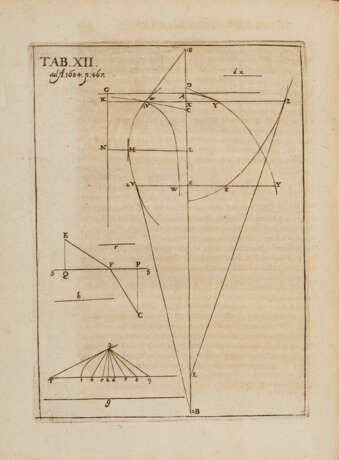ID 887821
Lot 48 | Nova Methodus pro Maximis et Minimis
Estimate value
$ 9 500 – 14 000
The true first edition of Leibniz’s classic paper containing his independent invention of the differential calculus, published in Vol III of the Acta eruditorum in 1684 and comprising pp. 467-173. “Only after the founding of the Acta eruditorum (1682) did Leibniz present his mathematical papers to the public ... In 1684 [Leibniz presented] the method of determining algebraic integrals of algebraic functions, a brief presentation of the differential calculus with a hint concerning the solution of Debaune’s problem by means of the logarithmic curve, and further remarks on the fundamental ideas of the integral calculus” (DSB). Leibniz was to become embroiled in a long dispute with Newton over priority in the discovery. It is now generally agreed that Newton anticipated Leibniz, but Leibniz's system was the first in print. The Leibnizian notation prevailed over the Newtonian and is the system in use today.
It has long been known that the 1684 paper exists in at least two different settings (see Edwin Wolf, The Library of James Logan, 1974, p. 4; also The Honeyman Collection, vol V, nos 1972-3) but no priority between the printings had been established before the research of Samuel V. Lemley. In fact this particular volume was reprinted by the publisher Mencke not once but twice, and it involved not only changes in typography, but also to Leibniz’s text. Lemley labels the two settings A and B, and demonstrates that the compositor of setting B did not understand the mathematical formulae, whereas the compositor of setting A did. He concludes that “the typographic and printing evidence presented in this article demonstrates that the first edition of Leibniz’s ‘Nova Methodus’ was printed in September 1684 by Christoph Günther and issued in October of that year; the second edition, incorporating the errata printed in March 1685, was printed in the summer of 1686, also by Christoph Günther; and the third edition, incorporating the March 1685 errata but omitting the June 1693 corrigenda, was printed between November 1692 and April 1693 by Christian Götze. This chronology alters significantly the abiding view that all three extant forms of Leibniz’s article (previously and variously called ‘states’, ‘versions’, and ‘printings’) are to be dated to 1684 and assigned to a single press. Rather, they are distinct and disjunct documents, with the third edition postdating the first by nearly a decade—that is, long after the discovery of the calculus had ceased to be news.”
For a detailed study of the publishing history of the Acta (without, however, mentioning the different printings) see Hub Laeven, The “Acta Eruditorum” under the editorship of Otto Mencke. The History of an international learned journal between 1682 and 1707 (Amsterdam, 1990); for the different printings, see Samuel V. Lemley, "Printing Leibniz’s Calculus: Dating and Numbering the Editions of the Nova Methodus pro Maximis et Minimis (October 1684)," in The Library (June 2021). Ravier 90; Dibner 109; Horblit 66a; Norman 1326; Parkinson p 121 (1682, Leibniz), p 122 (1683, Tschirnhaus), p 124 (1684, Leibniz); PMM 160; Sparrow 130#.
Quarto (198 x 160mm). With 14 engraved plates, 7 of which are folding and one of which pertains to Leibniz; an extraneous plate from the 1683 vol is also bound in). Contemporary German sheep, spine gilt (bit dry and rubbed).
| Artist: | Gottfried Wilhelm Leibniz (1646 - 1716) |
|---|---|
| Place of origin: | Germany |
| Auction house category: | Printed books |
| Artist: | Gottfried Wilhelm Leibniz (1646 - 1716) |
|---|---|
| Place of origin: | Germany |
| Auction house category: | Printed books |
| Address of auction |
CHRISTIE'S 8 King Street, St. James's SW1Y 6QT London United Kingdom | |
|---|---|---|
| Preview |
| |
| Phone | +44 (0)20 7839 9060 | |
| Buyer Premium | see on Website | |
| Conditions of purchase | Conditions of purchase |











